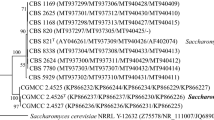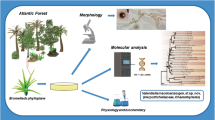Abstract
Three yeast strains of Yamadazyma dushanensis f.a., sp. nov. were isolated from rotten wood samples collected in the Dushan Forest Park, Nanyang, Henan Province, China. Sequence analyses of the D1/D2 domains of the large subunit rRNA gene and the internal transcribed spacer (ITS) regions revealed that this new species is located in the Yamadazyma clade (Debaryomycetaceae and Saccharomycetales), with three closely related species, namely, Yamadazyma terventina, Yamadazyma mexicana and Candida trypodendroni. The novel species differed from these three described species by 5–6 nt substitutions in the D1/D2 sequences. However, the ITS sequences of the new species were quite divergent from those of Y. terventina, Y. mexicana and C. trypodendroni with 12–18 nt substitutions. This new yeast species could assimilate cellobiose and other compounds related to rotting wood. The fermentation of cellobiose in Durham tubes was observed for the strains of this new yeast. The new species could also be distinguished from its closely related species, Y. terventina, Y. mexicana and C. trypodendroni, based on a number of morphological and physiological characteristics. The type strain is Y. dushanensis sp. nov. NYNU 14668 T (=CICC 33051T = CBS 13914T).


Similar content being viewed by others
References
Billon-Grand G (1989) A new ascosporogenous yeast genus: Yamadazyma gen. nov. Mycotaxon 35:201–204
Kurtzman CP, Robnett CJ (1998) Identification and phylogeny of ascomycetous yeasts from analysis of nuclear large subunit (26S) ribosomal DNA partial sequences. Antonie van Leewenhoek 73:331–371
Kurtzman CP, Suzuki M (2010) Phylogenetic analysis of ascomycete yeasts that form coenzyme Q-9 and the proposal of the new genera Babjeviella, Meyerozyma, Millerozyma, Priceomyces, and Scheffersomyces. Mycoscience 51:2–14
Kurtzman CP (2011) Yamadazyma billon-grand. In: Kurtzman CP, Fell JW, Boekhout T (eds) The yeasts, a taxonomic study, vol 2, 5th edn. Elsevier, Amsterdam, pp 919–925
Lachance MA, Boekhout T, Scorzetti G, Fell JW, Kurtzman CP (2011) Candida Berkhout. In: Kurtzman CP, Fell JW, Boekhout T (eds) The yeasts, a taxonomic study, vol 2, 5th edn. Elsevier, Amsterdam, pp 987–1279
Nakase T, Jindamorakot S, Ninomiya S, Imanishi Y, Kawasaki H, Potacharoen W (2008) Candida kanchanaburiensis sp. nov., a new ascomycetous yeast species related to Pichia nakazawae isolated in Thailand. J Gen Appl Microbiol 54:259–265
Groenewald M, Robert V, Smith M (2011) The value of the D1/D2 and internal transcribed spacers (ITS) domains for the identification of yeast species belonging to the genus Yamadazyma. Persoonia 26:40–46
Burgaud G, Arzur D, Sampaio JP, Barbier G (2011) Candida oceani sp. nov., a novel yeast isolated from a mid-atlantic ridge hydrothermal vent (−2300 meters). Antonie Van Leeuwenhoek 100:75–82
Ciafardini G, Zullo BA, Antonielli L, Corte L, Roscini L, Cardinali G (2012) Yamadazyma terventina sp. nov., a yeast species of the Yamadazyma clade from Italian olive oils. Int J Syst Evol Microbiol 63:372–376
Kaewwichian R, Yongmanitchai W, Kawasaki H, Wang PH, Yang SH, Limtong S (2013) Yamadazyma siamensis sp. nov., Yamadazyma phyllophila sp.nov. and Yamadazyma paraphyllophila sp. nov., three novel yeast species isolated from phylloplane in Thailand and Taiwan. Antonie Van Leeuwenhoek 103:777–788
Junyapate K, Jindamorakot S, Limtong S (2014) Yamadazyma ubonensis f.a., sp. nov., a novel xylitol-producing yeast species isolated in Thailand. Antonie Van Leeuwenhoek 105:471–480
Cadete RM, Santos RO, Melo MA, Mouro A, Gonçalves DL, Stambuk BU, Gomes FC, Lachance MA, Rosa CA (2009) Spathaspora arborariae sp. nov., a d-xylose-fermenting yeast species isolated from rotting wood in Brazil. FEMS Yeast Res 9:1338–1342
Barnett JA, Payne RW, Yarrow D (2000) Yeasts: characteristics and identification, 3rd edn. Cambridge University Press, Cambridge
Kurtzman CP, Fell JW, Boekhout T, Robert V (2011) Methods for isolation, phenotypic characterization and maintenance of yeasts. In: Kurtzman CP, Fell JW, Boekhout T (eds) The yeasts, a taxonomic study, 5th edn. Elsevier, Amsterdam, pp 87–110
White TJ, Bruns T, Lee S, Taylor J (1990) Amplification and direct sequencing of fungal ribosomal RNA genes for phylogenetics. In: Innis MA, Gelfand DH, Sninsky JJ, White TJ (eds) PCR protocols: a guide for methods and applications. Academic Press, New York, pp 315–322
Altschul SF, Madden TL, Schäffer AA, Zhang J, Zhang Z, Miller W, Lipman DJ (1997) Gapped BLAST and PSI-BLAST: a new generation of protein database search programs. Nucleic Acids Res 25:3389–3402
Thompson JD, Gibson TJ, Plewniak F, Jeanmougin F, Higgins DJ (1997) The CLUSTAL_X windows interface: flexible strategies for multiple sequence alignment aided by quality analysis tools. Nucleic Acids Res 25:4876–4882
Tamura K, Peterson D, Peterson N, Stecher G, Nei M, Kumar S (2011) MEGA5: molecular evolutionary genetics analysis using maximum likelihood, evolutionary distance, and maximum parsimony methods. Mol Biol Evol 28:2731–2739
Kimura M (1980) A simple method for estimating evolutionary rate of base substitutions through comparative studies of nucleotide sequences. J Mol Evol 16:111–120
Saitou N, Nei M (1987) The neighbor-joining method: a new method for reconstructing phylogenetic trees. Mol Biol Evol 4:406–425
Felsenstein J (1985) Confidence limits on phylogenies: an approach using the bootstrap. Evolution 39:783–791
Kurtzman CP (2006) Yeast species recognition from gene sequence analyses and other molecular methods. Mycoscience 47:65–71
Schoch CL, Seifert KA, Huhndorf S, Robert V, Spouge JL, Levesque CA, Chen W, The Barcoding Consortium (2012) The internal transcribed spacer as a universal DNA barcode marker for Fungi. Fungal Barcoding Consortium. Proc Natl Acad Sci USA 109:6241–6246
Nisiotou AA, Nychas GJ (2008) Kazachstania hellenica sp. nov., a novel ascomycetous yeast from a Botrytis-affected grape must fermentation. Int J Syst Evol Microbiol 58:1263–1267
Hawksworth DL (2011) A new dawn for the naming of fungi: impacts of decisions made in Melbourne in July 2011 on the future publication and regulation of fungal names. IMA Fungus 2:155–162
Suh SO, Nguyen NH, Blackwell M (2005) Nine new Candida species near C. membranifaciens isolated from insects. Mycol Res 109:1045–1056
Ganter PF (2006) Yeast and invertebrate associations. In: Rosa CA, Peter G (eds) The yeast handbook, biodiversity and ecophysiology of yeasts, 1st edn. Springer, Heidelberg, pp 303–370
Acknowledgments
This work was supported by the National Natural Science Foundation of China (31370073) and the Research Planning Project of Basic and Advanced Technology of Henan Province, China (122300410032).
Author information
Authors and Affiliations
Corresponding author
Additional information
Yun Wang and Yong-Cheng Ren have contributed equally to this work.
Rights and permissions
About this article
Cite this article
Wang, Y., Ren, YC., Li, Y. et al. Molecular Phylogeny and Taxonomy of Yamadazyma dushanensis f.a., sp. nov., a Cellobiose-Fermenting Yeast Species from China. Curr Microbiol 71, 268–273 (2015). https://doi.org/10.1007/s00284-015-0847-1
Received:
Accepted:
Published:
Issue Date:
DOI: https://doi.org/10.1007/s00284-015-0847-1




